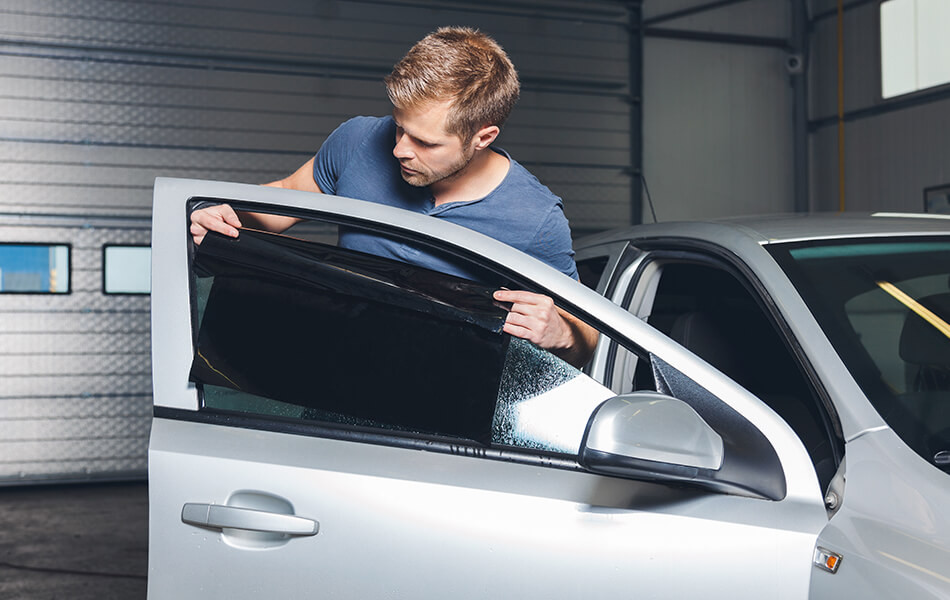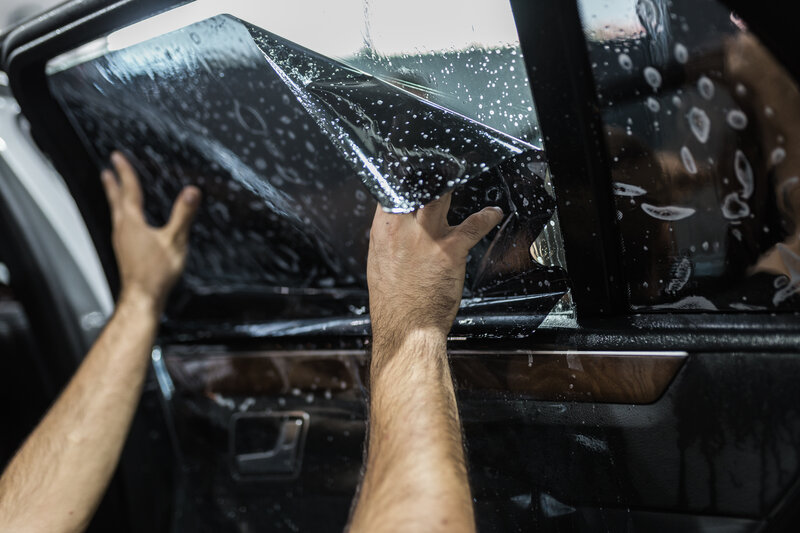Whatever You Required to Know Regarding Vehicle Window Tinting for Your Automobile
Vehicle home window tinting is a useful improvement for several vehicle proprietors. It provides advantages such as increased convenience and energy effectiveness. Numerous color films accommodate various demands and preferences. Recognizing lawful laws and choosing the appropriate tint percentage is crucial. The installation process and appropriate maintenance also play significant functions in making certain the longevity of the tint. What other variables should one think about prior to making a choice on home window tinting?
Advantages of Auto Window Tinting
Although some lorry owners might forget it, auto window tinting offers numerous advantages that boost both the driving experience and the lorry's long life. One of the key advantages is the reduction of heat accumulation inside the car, enabling a more comfy adventure, particularly during hot climate. This can bring about lowered dependence on air conditioning, improving gas efficiency.Additionally, window tinting provides defense against damaging UV rays, which can cause skin damages and fade interior products in time. By blocking these rays, the color aids maintain the automobile's interior and keep its resale value.Moreover, tinted windows can enhance personal privacy and safety, as they make it harder for outsiders to see inside the automobile. This added layer of defense can prevent prospective theft. In general, vehicle window tinting functions as a sensible investment that contributes to the car and both comfort's total wellness.
Types of Home Window Tint Films
When taking into consideration automobile window tinting, lorry owners encounter a range of window tint movies, each made to meet specific demands and choices. The initial group is colored window film, which offers a standard level of privacy and UV security while being cost-effective. Next off, metalized films incorporate tiny metal fragments, reflecting heat and enhancing longevity, although they may interfere with digital signals.Ceramic movies are one more alternative, known for their remarkable warmth rejection and clarity, using high efficiency without signal disturbance. Crossbreed movies combine qualities of colored and metalized films, striking a balance between price and capability. Each type of window tint film provides one-of-a-kind advantages, allowing car owners to select based upon their certain requirements, such as heat control, appearance, and budget plan factors to consider. Recognizing these alternatives is important for making an educated decision regarding vehicle home window tinting.
Recognizing Lawful Regulations
When considering automobile window tinting, it is important to comprehend the lawful guidelines that regulate tint darkness limitations and windshield color requirements. These laws can differ considerably from state to state, impacting what is permissible for vehicle proprietors. Acquainting oneself with these legislations assurances compliance and assists avoid prospective penalties or fines.
Color Darkness Limitations
Just how can automobile owners assure they remain compliant with local regulations regarding home window tinting? Understanding color darkness restrictions is vital. Each state has certain policies that determine the permitted degrees of darkness for window colors, which are determined by Visible Light Transmission (VLT) portions. Generally, front-side home windows have to enable a higher portion of light compared to back home windows. Some states might enable just 30% VLT for front home windows, while the back home windows might be permitted to have notably darker colors. To guarantee conformity, vehicle owners need to speak with state standards or neighborhood police for exact details. Furthermore, licensed tinting professionals can supply understandings about legal limitations, making certain that car proprietors make informed decisions.
Windscreen Color Regulations

State-Specific Legislations
Guiding with the landscape of state-specific laws relating to automobile window tinting requires cautious focus to information, as policies can vary substantially from one state to another. Each state has its own collection of rules controling allowed color portions, kinds of materials, and placement on car windows. For example, some states permit darker tints on rear home windows while restricting them on front windows, while others have stricter overall limits. Additionally, particular states mandate the usage of certain products or call for qualification from installers. Failing to follow these policies can result in penalties or the need to remove non-compliant tint. Subsequently, automobile owners need to consult their state's Division of Motor Vehicles or pertinent authority to ensure adherence basics to regional regulations
Choosing the Right Color Portion
When selecting the appropriate color percentage for an automobile's home windows, one need to think about numerous aspects that affect both aesthetic appeals and functionality. Color portions generally vary from 5% to 70%, with lower percents offering darker tones and higher percents enabling extra light in. A darker tint can boost privacy and lower glare, while a lighter tint can keep visibility and follow lawful restrictions.Furthermore, personal choice plays a substantial function in this choice. Some individuals may favor the streamlined look of darker tints, while others could favor a much more open, airy feel. In addition, the lorry's objective need to be thought about; for example, those using their lorries for commercial functions may decide for lighter tints to preserve an expert look.Ultimately, the appropriate tint portion equilibriums individual design, convenience, and adherence to local guidelines, guaranteeing a satisfying tinting experience.
The Setup Refine
A successful setup of window tint requires mindful attention to detail and the right devices. The procedure generally begins with comprehensive cleaning of the home windows to get rid of debris, dust, and dust, assuring appropriate bond of the film. As soon as the surface areas are prepared, the installer procedures and reduces the tint film to fit each window accurately.Next, the movie is positioned on the glass, typically utilizing a remedy to assist in very easy modification and stop air bubbles. Warm is sometimes put on the movie to adapt it to the window's curves, boosting its look and long life. After verifying a seamless fit, the installer diligently trims any excess movie along the edges.Finally, the installer checks for blemishes and confirms all edges are protected. This thorough technique is vital not just for aesthetics however also for attaining the desired efficiency advantages of window tinting, such as UV defense and heat decrease.
Maintenance and Treatment for Tinted Windows
Proper upkeep and care are necessary for preserving the integrity of colored windows. Efficient cleansing techniques, the evasion of hazardous chemicals, and normal inspections for damages play important roles in making sure long life. By complying with these standards, vehicle owners can keep the useful and visual advantages of their window tint.
Cleaning Strategies for Tint
Maintaining the clearness and long life of colored home windows needs certain cleansing methods tailored to the movie's fragile surface. It is essential to make use of a soft microfiber cloth to stay clear of scraping the tint while cleansing. A mild remedy of water and a few decreases of moderate recipe soap can properly remove dust and crud. It is advisable to apply the cleaning remedy to the fabric, instead of straight onto the tinted surface area, to stop wetness from permeating into the edges of the film. Gentle, circular movements should be employed to clean up the home windows thoroughly. Regular cleaning helps maintain visibility and avoids buildup, making sure that the tint stays in prime condition over time. Following these methods will extend the life of tinted windows.
Avoiding Dangerous Chemicals
Many house cleansing items are reliable on different surfaces, they can pose substantial threats to tinted windows. Chemicals such as ammonia, bleach, and certain solvents can degrade the color film, causing discoloration and peeling. Individuals need to go with pH-balanced cleansers particularly designed for colored windows. Additionally, utilizing soft microfiber cloths will certainly assist prevent scrapes and preserve the color's stability. Regular upkeep is important; subsequently, preventing severe scrubbing up or abrasive products is vital. It is recommended to review product tags thoroughly to confirm compatibility with home window tints. By choosing the right cleaning remedies and tools, vehicle owners can maintain the appearance and performance of their tinted windows, assuring a longer life expectancy and peak performance.
Evaluating for Damage
Routine inspections of colored home windows are essential for identifying any indicators of damages that may endanger their performance and appearance. Proprietors need to look for gurgling, peeling, or discoloration, as these concerns can indicate bad installment or exposure to harmful aspects. It is a good idea to check the sides of the movie where peeling off might check and begin for any scrapes that can impact exposure. Additionally, ultraviolet (UV) rays can cause the color to weaken over time, so checking its efficiency in obstructing UV light is essential. If any damage is identified, punctual activity should be taken, which might include specialist repair or replacement. Maintaining colored home windows not only improves visual appeals however likewise assurances continued protection for both passengers and the vehicle interior.
Common Misconceptions Concerning Home Window Tinting
What misconceptions border home window tinting for automobiles? Lots of individuals believe that all window colors are unlawful, however guidelines vary by state, permitting details degrees of tinting. One more common myth is that darker colors obstruct even more heat; however, the performance of home window films depends on their modern technology instead than darkness. Some people also believe that window tinting is solely for aesthetics, overlooking its advantages, such as UV security and glare decrease. Furthermore, numerous image source assume that window tinting will certainly damage their vehicle's glass, yet skillfully applied colors can actually improve glass toughness. There is a belief that home window tints obstruct exposure, yet top quality movies are developed to keep clear sightlines while offering personal privacy. Recognizing these myths aids consumers make educated choices regarding window tinting, guaranteeing they delight in the complete series of benefits it supplies.
Frequently Asked Concerns
Just How Lengthy Does Home Window Tinting Normally Last?
The long life of window tinting varies based upon elements such as installation high quality, movie type, and environmental conditions. Typically, top quality tint can last anywhere from 5 to 10 years prior to needing substitute or reapplication.
Can I Eliminate Window Tint Myself?
Getting rid of home window tint oneself is feasible, though it might be challenging. Individuals should make use of a warmth source and adhesive remover to alleviate the procedure, however care is advised to avoid damaging the vehicle's glass or inside.
What Devices Are Required for Do It Yourself Home Window Tinting?

Will Home Window Tinting Damages My Car's Glass?
Window tinting, when applied correctly, typically does not damage a vehicle's glass. Incorrect setup or low-quality films might lead to peeling off, gurgling, or damaging, possibly jeopardizing the stability of the glass over time.
Can Tinted Windows Impact My Automobile's Resale Worth?
The effect of tinted windows on a vehicle's resale value can vary. While some purchasers appreciate the added privacy and UV defense, others might watch it as a prospective problem, possibly affecting resale positively or negatively. When considering automobile home window tinting, car owners experience a variety of home window color films, each developed to meet details demands and choices. When considering auto home window tinting, it is crucial to recognize the legal regulations that control color darkness limitations and windscreen color requirements. Typically, front-side home windows must permit a higher percentage of light compared to rear home windows. Some states might allow just 30% VLT for front windows, while the back home windows might be allowed to have especially darker colors. Some states permit darker colors on rear home windows while prohibiting my site them on front windows, while others have stricter overall restrictions.